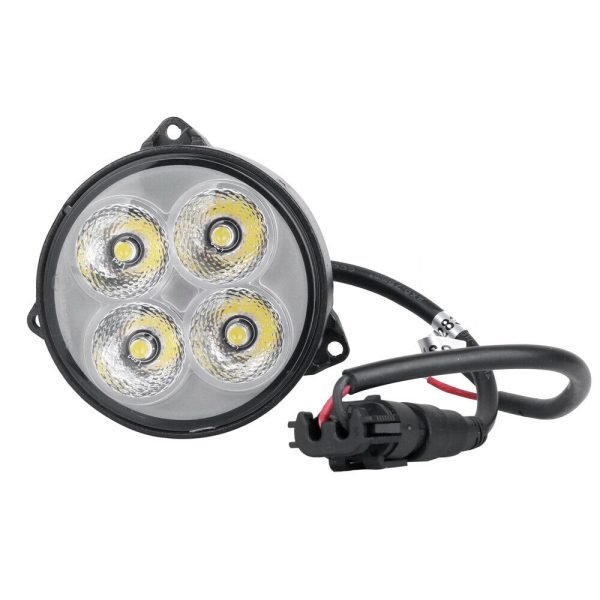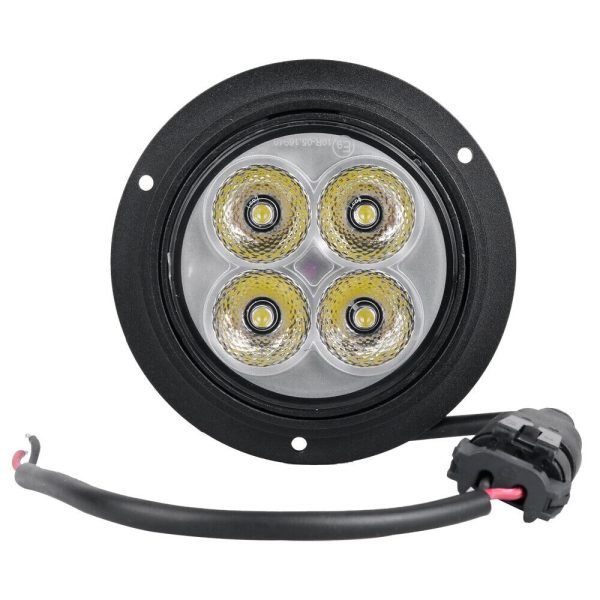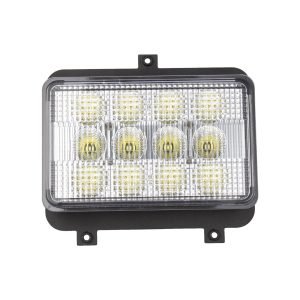Introduction
Imagine working on the farm in total darkness, right into the dead of night. It certainly is cumbersome, but it could also be perilous. Yet, with the right tools, nighttime farming is practically the same as daytime farming. Among the top items for this activity is excellent lighting, specifically for tractors, which is essential to modern agriculture. LED technology is efficient and bright, changing the game. The tractor headlights LED have brought about a revolution, not in comparison to the old-style lights but in farming with artificial lighting at night.
We will discuss how these lights make working at night safer and more productive, examine their economic benefits, and consider their environmental impact.
We shall also look into the future and the new advancements we can expect in this exciting area of agricultural technology. This writing will help you understand the ever-growing rate at which more and more farmers are turning to LED headlamps and how this is shaping the future of agricultural practice.

Technical Advancements in Tractor Headlights LED
For instance, some apparent differences in comparing tractor headlights LED with traditional ones include that conventional tractors have either halogen or HID bulbs. These lights have been around for a long time, and although they do the job, they come with several drawbacks, like consuming a lot of power and having a shorter lifespan.
However, LED technology is a more advanced development that has many benefits. Following are some of the fundamental technical advancements that make LED lights a better choice for tractors:
Brightness and Clarity
The light from the LED is bright and clear, like natural daylight, so the farmer can work with little to no darkness, avoid obstacles, and be more precise when using the machinery.
Energy Efficiency
The power consumed is significantly lower compared to halogen or HID lights, which means the tractor’s battery will last much longer, and the farm will have fewer energy costs.
Durability and Reliability
LED lights are way too durable due to the absence of filaments or even glass elements that can easily break. They were devised to deal with vibrations and knocks from operating a tractor on a rough field.
Longevity
It is coupled with the fact that an LED light can last up to 30,000 hours compared to a standard halogen that would be replaced between 500 and 1,000 hours, which makes it a major saver on maintenance and replacement over the tractor’s lifetime.
These advances make night farming efficient, safe, and economical by reducing the cost of maintenance and energy. While the initial cost of purchasing LED lighting is high, the benefits derived through the use of such lighting are long-term and over and above the initial cost of purchase.
In the following subsections, we will see how these benefits are extended and enhance more than just lighting but farm productivity and safety, respectively.

Enhancing Safety and Productivity with LED Headlights
So, one of the benefits of these LED headlights on tractors is an increase in safety and productivity for night farming. When there are risks in a work environment, especially at night, adequate lighting is important to ensure safety; for instance, a farm environment is characterized by rough terrains, water bodies, and obstructing obstacles.
Improving Visibility at Night
The LED headlamps offer bright lights, emitting a white light to assist in visibility. Further, farmers can see further and very well in the dark, which is important in detecting potential hazards in advance. Improvements in light coverage prevent useless stops and slow-downs, ensuring the smooth running of the machinery.
Reducing Accidents and Enhancing Safety
Studies have already proved that better lighting can reduce the number of accidents. In contrast, LED lights will give farmers a clearer sight of their surroundings and prevent collisions with other equipment or unexpected obstacles, therefore protecting the equipment, crops, and, most importantly, farmers.
Increasing Working Hours and Productivity
Some seasons have sunsets at very early times, limiting farmers’ working hours during the day.
It will reverse the trend of early cessation of farm activities, as working will stretch well into the night with LED lamps guaranteeing safety and efficiency. It means better time management by the farmer and more productivity since they are not restricted to working hours during the day. For instance, during the peak harvesting season, when time is highly valued, working during the night will increase the output and efficiency of the farm.
Case Examples
Most farmers who have embraced LED headlights confess that in addition to the longer working hours, fatigue has decreased.
Strains on the eyes, caused by glare or even insufficient lighting emitted from traditional lighting, can lead to early fatigue. LED lights reduce such straining through better color clarity and uniform light distribution, thus allowing the farmers to work long hours without feeling tired.

Economic Benefits of LED Headlights
Installing LED headlights on a tractor not only improves safety and extends the time of work but also provides an economic advantage, which results from energy savings, a reduction in the cost of maintenance, and long life, among other factors.
Cost Savings on Energy
LED lights are far more energy efficient than halogen or HID lights. They use only a fraction of the power and still generate more light volume output.
That reduction of power does save a considerable amount in fuel costs, as one needs less power supply to a tractor just to run the lights. This quickly adds up to very important savings for a farmer who uses his tractor extensively.
Reduced Maintenance and Replacement Costs
One economic advantage of LEDs, single-handedly more important than all, is the long lifetime. An LED light, on average, will last 30,000 hours, compared to an average halogen bulb’s life span of 500 to 1,000 hours.
Due to this long lifespan, replacements do not have to be conducted frequently, which will minimize the costs associated with replacing them and the downtime caused by maintenance activities. In addition, LEDs are tough and resistant to breakage because they are made without filaments or glass enclosures.
This ruggedness reduces the risk of damage from vibrations and impacts joints in farm operations, further reducing maintenance requirements.
Return on Investment (ROI)
Although the initial cost of tractor headlights is higher than that of traditional lights, the economic payback is good. A blend of energy-saving, low maintenance, and the absence of need for replacement combine to justify long-term investment in LED lights.
A farmer can compute the return on investment using many savings against the initial cost and will likely find LEDs cost-effective in the long run.
Testimonials from Farmers
Many farmers who have invested in the lights have saved costs and improved their work efficiency. They claim to work longer and harder without fear that lights will go off; therefore, they can utilize time and resources to their best, especially during crucial planting and harvesting periods.

Environmental Impact of LED Technology
Tractor headlights LED would have a higher level of safety and efficiency and be more environmentally friendly; moreover, today, they are becoming more relevant to the agricultural sector, which is becoming sustainable and reducing the ecological footprint.
Energy Efficiency and Lower Carbon Emissions
LED lamps are highly power efficient and consume far less energy than older conventional lighting options like halogen or HID bulbs. This directly affects the general goal of reducing greenhouse gases, specifically if the power comes from renewable sources or if the tractor engine is efficient enough.
In overall carbon output, less power consumed by LED headlights helps to that effect, supporting an important general goal: reducing greenhouse gases.
Reduced Light Pollution
LED lights are designed to focus light intensity and scatter with less light and flashes. Such effective lighting control assists in reducing light pollution, especially in rural areas’ ecosystems.
Light pollution can negatively affect wildlife and, in most cases, affects the cycles of plants. Through focusing on lighting, LEDs help to maintain the natural environment, mainly in agricultural areas that support the ecosystem.
Longevity and Waste Reduction
LED lighting has a very long life, so it does not require frequent replacement like traditional bulbs. Because of this longevity, far fewer wastes are generated from used bulbs.
Furthermore, because these bulbs do not contain the dangerous element of mercury, like other bulb types, the more responsible means of disposal are necessarily less hazardous. Therefore, the hazard of LED waste is decreased, which in itself makes the overall LED technology more friendly to the environment.
Government Incentives and Sustainability Programs
Most governments and environmental agencies have their ways of giving incentives to farmers who conserve energy and practice agriculture in a way that will not increase carbon emissions into the atmosphere.
There are many cases in which the adoption of LED technology could be beneficial, from financial incentives to contributing to the general sustainable practice of agriculture.

Future Innovations in Agricultural LED Technology
As technology continues to evolve, the future of LED lighting in agriculture looks promising. Several innovations are on the horizon that could further enhance farming efficiency and sustainability.
Smart LED Lighting Systems
One of the most exciting developments is the integration of smart technology with LED lighting systems. These smart LEDs can controlled remotely and programmed to adjust brightness based on the time of night or the tasks performed.
This adaptability improves energy efficiency and tailors the lighting to meet the exact needs of the farm, enhancing productivity and reducing waste.
Integration with IoT Devices
The future of LED lights in agriculture includes integrating with the Internet of Things (IoT). Sensors and connected devices can work with LED systems to create a more cohesive farming operation.
For example, sensors could detect when and where light is needed most, automatically adjusting LED brightness or direction, thereby optimizing the use of tractors and other machinery during nighttime operations.
Advancements in Light Quality and Spectrum
Research continues to develop LEDs that mimic natural sunlight even more closely, which could improve growth conditions for crops during nighttime operations or in indoor settings. LEDs that can adjust their light spectrum based on the needs of specific crops could revolutionize plant growth and yield, especially in controlled environments like greenhouses.
Increased Energy Efficiency and Solar Integration
Future LED technology is likely to become even more energy-efficient. Coupled with advancements in solar power, this could lead to completely self-sustaining lighting systems for tractors and other farm equipment.
Solar-powered LEDs would reduce reliance on traditional energy sources and offer a fully renewable solution, enhancing the sustainability of farming operations.
Challenges and Solutions
Despite these exciting developments, adopting new technologies can be challenging, including cost, technical complexity, and resistance to change. Continued innovation in cost reduction, user-friendly design, and education about the benefits of LED technology will be essential to overcome these barriers.

Conclusion
In conclusion, throughout this article, we’ve explored how advanced tractor headlights LED revolutionize night farming across America. From enhancing visibility and safety to improving economic efficiency and reducing environmental impact, the benefits of LED technology in agriculture are profound and far-reaching.
LED headlights provide brighter, more efficient, and longer-lasting light, enhancing safety by improving visibility and extending working hours, allowing farmers to be more productive. Economically, these lights offer significant cost savings through reduced energy consumption and lower maintenance needs. Environmentally, they contribute to sustainability efforts by reducing energy use and light pollution, aligning with global goals to combat climate change.
Call to Action
Elevate your farming experience with Dual Vision LED’s 100W LED Case IH Magnum Headlights. These state-of-the-art lights offer superior visibility and unmatched efficiency, making night farming safe and productive. Designed specifically for your Case IH Magnum, they ensure a perfect fit and easy installation.
Don’t let poor lighting hold you back. Upgrade to Dual Vision LED and extend your farming hours without sacrificing safety or quality. Visit Dual Vision LED today to discover how these powerful tractor headlights LED can transform your agricultural operations. Brighten your field and your future with Dual Vision LED!
